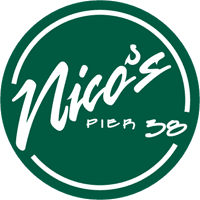From the boat, to the table
Fresh from the boat
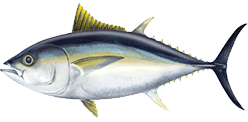
Big Eye
Source: Hawaii-Seafood.org
In Hawaii, “Ahi” refers to two species, the Bigeye Tuna and the Yellowfin Tuna.
Caught in deeper, cooler water, it typically has a higher fat content than Yellowfin and is preferred by sashimi lovers.
Fishing Method
All Hawaii bigeye tuna are line-caught. Most of Hawaii’s bigeye tuna are caught by deep-set longline fishing gear off shore of Hawaii.
Preparation
Texture: Firm
Flavor: Mild
Suggested Preparations: Grill, Broil, Sauté, Raw
Health & Nutrition
Hawaii Bigeye Tuna is an excellent source of healthy, extra lean protein.
Sustainability
Overfishing has been eliminated in the Hawaii fishery due to strict enforcement of bigeye catch quota. Overfishing is occurring in international fishery in the western and central Pacific.
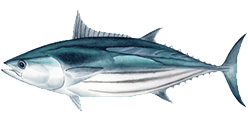
Aku (Skipjack)
Source: Hawaii-Seafood.org
Skipjack tuna is commonly called aku in Hawaii. Aku are extremely important food fish in Hawaiian and Pacific Island cultures and in Japan.
Fish caught in the vicinity of the Hawaiian Islands range from 4 to 30 pounds in weight. During peak season, larger fish (16 to 30 pounds) known locally as “otaru”, move into Hawaiian waters.
Fishing Method
All Hawaii skipjack tuna are line-caught. Most of Hawaii’s skipjack tuna are caught by pole & line (aku boats) using live bait to attract fish and barbless hooks to catch them.
Preparation
Texture: Firm
Flavor: Rich
Suggested Preparations: Raw (sashimi, poke), Seared (tataki), Broiled, Fried, Sautéed, Dried
Health & Nutrition
Hawaii Skipjack Tuna is an excellent source of healthy, extra lean protein.
Sustainability
Hawaii skipjack tuna are being fished sustainably. Overfishing is not occurring in the Hawaii fishery or in the western and central Pacific.
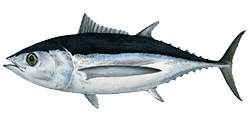
Albacore
Source: Hawaii-Seafood.org
Hawaiian Name: Ahipalaha; tombo ahi
Commonly called tombo ahi in Hawaii. “Tombo” means dragonfly in Japanese and refers to the very long pectoral fins of the albacore that can equal as much as 30% of the total length.
Fish caught in the vicinity of the Hawaiian Islands are large adults (40 to 80 pounds in weight). Hawaii albacore in excess of 50 pounds are preferred. They have a greater yield and more attractive pink color.
Fishing Method
All Hawaii albacore tuna are line-caught. Most of Hawaii’s albacore tuna are caught by longline fishing gear off shore of Hawaii.
Preparation
Texture: Firm
Flavor: Moderate to Rich
Suggested Preparations: Raw (sashimi, sushi, poke, ceviche), Seared, Broiled, Baked, Sautéed, Dried, Smoked, Tempura
Health & Nutrition
Hawaii Albacore Tuna is an excellent source of healthy, extra lean protein.
Sustainability
Hawaii albacore tuna are being fished sustainably. Overfishing is not occurring in the Hawaii fishery or in the western and central Pacific.
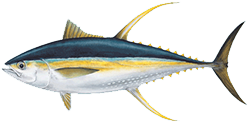
Yellowfin
Source: Hawaii-Seafood.org
In Hawaii, “ahi” refers to two species, the yellowfin tuna and the bigeye tuna. It has a slimmer profile than the bigeye tuna, with distinctive soft dorsal and anal fins and finlets are bright yellow. The dorsal and anal fins tend to lengthen with age.
Fish landed in Hawaii range from 3 to well over 200 pounds. Smaller fish are usually caught around fish aggregation buoys and over seamounts. The large fish (over 100 pounds) are usually caught in deep open ocean waters.
Fishing Method
All Hawaii yellowfin tuna are line-caught. Most of Hawaii’s yellowfin tuna are caught by deep-set longline fishing gear off shore of Hawaii.
Preparation
Texture: Firm
Flavor: Mild
Suggested Preparations: Raw (sashimi, sushi, poke), Seared, Grilled, Broiled, Sautéed, Dried
A preferred species for sashimi. Also excellent for grilling and in seared or “blackened” fish preparations.
Health & Nutrition
Hawaii Yellowfin Tuna is an excellent source of healthy, extra lean protein.
Sustainability
Hawaii yellowfin tuna are being fished sustainably. Overfishing is not occurring in the Hawaii fishery or in the western and central Pacific.

Broadbill
Source: Hawaii-Seafood.org
Hawaii Market Names: mekajiki, shutome
Hawaiian Name: A`u
Swordfish caught in Hawaiian waters are between 10 and 600 pounds with most weighing in at 100 to 300 pounds.
Hawaii is the major source of domestic swordfish in America.
All of Hawaii’s swordfish are landed, marketed fresh and sold at the Honolulu fish auction, where most wholesalers acquire their fish for local, domestic and export sales.
Swordfish flesh may vary from pale to pinkish. Its flavor is mild.
Fishing Method
All Hawaii swordfish are line-caught. Longline boats fishing considerable distances from Hawaii land the overwhelming majority of the catch. Fresh Hawaii swordfish are not caught by gill nets or by harpoons as they are in other fisheries that supply the fresh and frozen swordfish market.
Preparation
Texture: Firm
Flavor: Mild
Suggested Preparations: Grilled, Broiled, Raw
Health & Nutrition
Hawaii swordfish, also known as mekajiki, is an excellent source of lean protein.
Sustainability
Hawaii swordfish are being fished sustainably. Overfishing is not occurring in the Hawaii fishery or in the western and central Pacific.

Shortbill
Source: Hawaii-Seafood.org
Hawaii Market Name: Hebi
Shortbill spearfish are commonly known as Hebi in Hawaii.
Hebi has white to pink colored flesh that is somewhat softer than that of Nairagi or Kajiki.
Fishing Methods
All Hawaii spearfish are line-caught. Longline boats that set hooks in deep water harvest most of the spearfish catch in Hawaii.
Seasonality
Hebi is available year round.
Preparation
Texture: Softer than Nairagi and Kajiki
Flavor: Mild
Suggested Preparations: Broiled, Grilled, Sautéed, Raw (poke)
Health & Nutrition
Hawaii Spearfish is an excellent source of healthy, extra lean protein.

Blue Marlin
Source: Hawaii-Seafood.org
Kajiki is commonly known as Pacific blue marlin, or a`u, the Hawaiian name applied to all marlin species
Flesh color in kajiki ranges from white to pink, although it varies somewhat from fish to fish
Fishing Methods
All Hawaii blue marlin are line-caught.
Preparation
Texture: Firm
Flavor: Mild Pronounced
Suggested Preparations: Raw (poke, sashimi), Grilled, Fried, Sautéed, Smoked
Health & Nutrition
Hawaii Blue Marlin is an excellent source of healthy, extra lean protein.

Striped Marlin
Source: Hawaii-Seafood.org
Nairagi is commonly known as striped marlin, or a`u, the Hawaiian name applied to all marlin species.
The flesh color of striped marlin varies from fish to fish and varies from light pink to orange-red.
Nairagi caught around the Hawaiian Islands usually between 40 and 100 pounds in round weight and are rarely over 130 pounds.
Fishing Methods
All Hawaii striped marlin are line-caught. Most of the catch in Hawaii is by longline boats fishing in the open ocean.
Preparation
Texture: Firm
Flavor: Mild
Suggested Preparations: Raw (sashimi, sushi, poke, ceviche), Broiled, Grilled, Sautéed, Smoked, Tempura
Health & Nutrition
Hawaii Striped Marlin is an excellent source of healthy, extra lean protein.
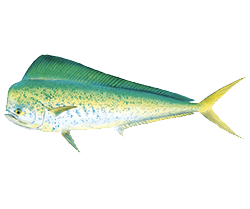
Mahi Mahi
Source: Hawaii-Seafood.org
Hawaiian Name: Mahimahi
Japanese Name: Shiira
Mahimahi is thin-skinned with firm, light pink flesh.
It has a delicate flavor that is almost sweet. Hawaii’s Mahimahi is a highly-regarded product which is best eaten when fresh.
The supply of locally caught Mahimahi is limited and seasonal considering the high demand for this species. Mahimahi over 15 pounds in body weight is the preferred market size.
No fish is better known in the upscale restaurant market than Hawaii’s fresh Mahimahi, which has become synonymous with tourism. Among visitors, is one of the State’s best-known fish.
Fishing Method
All Hawaii mahimahi are line-caught. Longline boats harvest most of the mahimahi catch in Hawaii. However, mahimahi are also caught by trollers using lures and baits.
Preparation
Texture: Firm
Flavor: Mild & Sweet
Suggested Preparations: Grilled, Broiled, Sautéed, Tempura
Health & Nutrition
Hawaii Mahimahi is an excellent source of healthy, extra lean protein.
Sustainability
Hawaii mahimahi population status is not formally assessed but assumed to be stable. Overfishing does not appear to be occurring in the Hawaii fishery. Catch rates indicate that the population is not overfished.
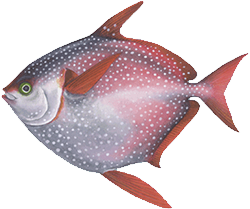
Opah
Source: Hawaii-Seafood.org
Japanese Name: Akamanbo
An opah has three types of flesh, each a different color. Behind the head and along the backbone is an attractive orange colored flesh. Toward the belly, the flesh pales to a pink color. The fish’s cheeks yield dark red flesh.
It is rich and tasty. Previously underutilized, there is a rising demand for opah, particularly in the restaurant trade.
Opah landed in Hawaii range from 60 to over 200 pounds in weight. A pelagic wandering species, it is often found in the company of tunas and billfish.
All of the opah landed in Hawaii are caught by longlining. Almost all opah sold in the U.S. market are from Hawaii.
Fishing Method
All Hawaii opah are line-caught. Longline boats harvest the opah landed in Hawaii.
Preparation
Texture: Firm
Flavor: Rich
Suggested Preparations: Raw (sashimi), Broiled, Baked, Sautéed, Steamed, Smoked
Health & Nutrition
Hawaii Moonfish is a rich source of protein, niacin, vitamin B6, vitamin B12, phosphorus, and selenium. It is also low in sodium.
Sustainability
Hawaii opah are being fished sustainably. Very little is known about opah and Hawaii opah population status is not formally assessed. There is no evidence that opah populations are in decline, or that overfishing is occurring.
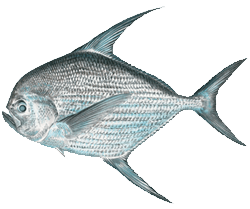
Monchong
Source: Hawaii-Seafood.org
Hawaiian Name: Mukau
Japanese Name: Monchong; Hire Jiro Monchong
Monchong has a highly transparent, clear, white flesh with pinkish tones. It is firm in texture and moderate in flavor.
Monchong can range from about 4 pounds to over 25 pounds, but the prime market sizes are fish over 12 pounds.
Fishing Method
All Hawaii monchong are line-caught. Longline boats harvest most of the monchong catch in Hawaii. However, some monchong are also caught by deepwater handline gear with power reels.
Preparation
Texture: Firm
Flavor: Moderate
Suggested Preparations: Grilled, Broiled, Baked, Sautéed
Health & Nutrition
Hawaii Sickle Pomfret is an excellent source of healthy, extra lean protein. It is also low in saturated fat and low in sodium.
Sustainability
Only small quantities of monchong are available because it is not usually targeted by fishermen. There are no well-defined seasonal trends in availability.
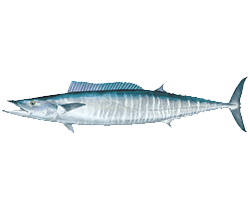
Ono
Source: Hawaii-Seafood.org
Hawaiian Name: Ono Malani
Japanese Name: Kamasu-sawara
Monchong has a highly transparent, clear, white flesh with pinkish tones. It is firm in texture and moderate in flavor.
Monchong can range from about 4 pounds to over 25 pounds, but the prime market sizes are fish over 12 pounds.
Fishing Method
All Hawaii monchong are line-caught. Longline boats harvest most of the monchong catch in Hawaii. However, some monchong are also caught by deepwater handline gear with power reels.
Preparation
Texture: Firm
Flavor: Moderate
Suggested Preparations: Grilled, Broiled, Baked, Sautéed
Health & Nutrition
Hawaii Sickle Pomfret is an excellent source of healthy, extra lean protein. It is also low in saturated fat and low in sodium.
Sustainability
Hawaii wahoo are being fished sustainably. Pacific wahoo population status is estimated to be high. But no information is available about whether overfishing is occurring or not.
